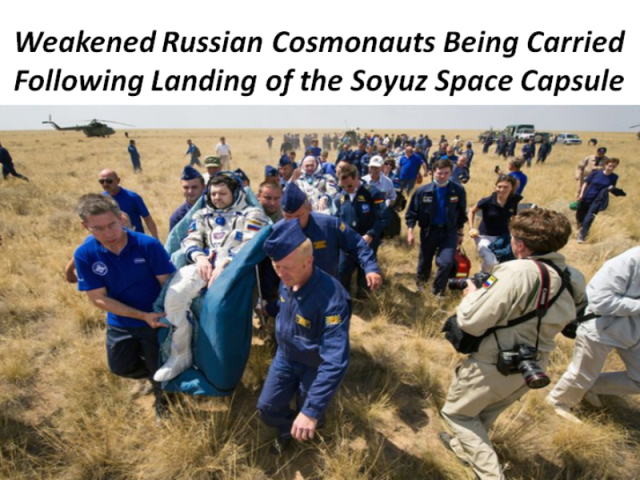Human Frailty May Keep NASA from Meeting the Little Green MenOctober 16, 2017 No one is certain whether little green men really live on Mars. But if they do, human frailty may keep us from ever meeting them. We have the technology to put men and women on Mars, but with NASA’s current health and spacesuit technology, they probably wouldn't survive the trip. Why? Have you ever noticed that when astronauts return to the earth after six months on the space station, they disappear for several months following the smiling publicity shots? That’s because their bodies take a while – sometimes a long while – to adjust to the normality of earth. Most astronauts exercise several hours a day on their missions to counteract the harmful effects of living in space, but it still takes months of rehabilitation to adjust to living on earth after a typical six-month space mission. Some of the ill-effects space travelers experience include up to a 22% loss in blood volume in two to three days; muscles in the legs, neck, and back losing as much as 20% of their mass; and bones atrophy between 1% and 2% per month in space. Some astronauts have been documented as experiencing as much as 20% loss of bone mass on six-month flights. Even a few days in space can cause health problems. After spending just two weeks in space in 2006, Heidemarie Stefanyshyn-Piper collapsed during a press conference after landing, because her body had not adjusted to the gravitational and magnetic field of the earth. "We normally say that it takes a day of recovery on Earth for each day that somebody's in space," explains Dr. Victor Schneider, research medical officer for NASA headquarters. Some adverse effects may never be reversed. Let’s look at the three primary problems that NASA must address before humans can safely undertake an extended mission of three years (such as a meet and greet with the little green men of Mars).
Most non-scientists assume that these adverse health effects are due to the lack of contact with the earth’s gravitational field. That is partly true. But another critical factor that is missing from the lives of space explorers is the lack of contact with the earth’s magnetic field. According to one doctor, “Space program managers are keenly aware that it is not just a lack of gravity that has a negative impact on astronauts' bodies, but the lack of the earth's magnetic field.” The 2015 “Review of NASA's Evidence Reports on Human Health Risks” was released by National Academies of Science, Engineering, and Medicine. Its recommendations include that NASA should:
Fortunately, NASA has learned about a technology that provides an electromagnetic field safely and has partnered with the European company that pioneered the technology. Together they plan to engineer the next generation of spacesuits. The technology can increase blood flow and oxygenation of the body’s cells. The hope is that it will eliminate or mitigate many of the problems described in this article, and hasten the recovery time of the brave astronauts who risk their lives to advance scientific knowledge. INTERNET RESEARCH: CNBC: The Health Risks of Spending a Year in Outer Space https://www.cnbc.com/2016/01/07/the-health-risks-of-spending-a-year-in-outer-space.html Space.com: Weightlessness and its Effect on Astronauts https://www.space.com/23017-weightlessness.html NASA: Gravity Hurts (So Good) https://science.nasa.gov/science-news/science-at-nasa/2001/ast02aug_1 NASA Fact Sheet on Muscle Atrophy in Space https://www.nasa.gov/pdf/64249main_ffs_factsheets_hbp_atrophy.pdf NASA Fact Sheet on Bone Atrophy in Space https://science.nasa.gov/science-news/science-at-nasa/2001/ast01oct_1 NASA: Cardiovascular Health Consequences of Long-Duration Space Flight https://www.nasa.gov/mission_pages/station/research/experiments/756.html What Are the Long-Term Effects of Living in Space? NASA is Studying Twins Mark & Scott Kelly to Find Out. http://www.latimes.com/science/la-sci-nasa-twin-study-20160707-snap-story.html
| ||||
 Dr. Tom Barrett is a pastor, teacher, author, conference keynote speaker, professor, certified executive coach, and marketplace minister. His teaching and coaching have blessed both church and business leaders. He has been ordained for over 40 years, and has pastored in seven churches over that time. Today he “pastors pastors” as he oversees ordained and licensed ministers in Florida for his ministerial fellowship. Dr. Tom Barrett is a pastor, teacher, author, conference keynote speaker, professor, certified executive coach, and marketplace minister. His teaching and coaching have blessed both church and business leaders. He has been ordained for over 40 years, and has pastored in seven churches over that time. Today he “pastors pastors” as he oversees ordained and licensed ministers in Florida for his ministerial fellowship.He has written thousands of articles that have been republished in national newspapers and on hundreds of websites, and is a frequent guest on radio and television shows. His weekly Conservative Truth article (which is read by 250,000) offers a unique viewpoint on social, moral and political issues from a Biblical worldview. This has resulted in invitations to speak internationally at churches, conferences, Money Shows, universities, and on TV (including the 700 Club). “Dr. Tom,” as his readers and followers affectionately refer to him, has a passion for teaching, as you can see from his ministry website (www.ChristianFinancialConcepts.com); his patriotic site (www.ConservativeTruth.org); and his business site (www.GoldenArtTreasures.com). Tom's friend Dr. Lance Wallnau wrote of him, "Tom Barrett is a Renaissance man with a passion for subject matter ranging from finance to theology and American history." Visit Dr. Tom Barrett's website at www.DrTom.TV
|
